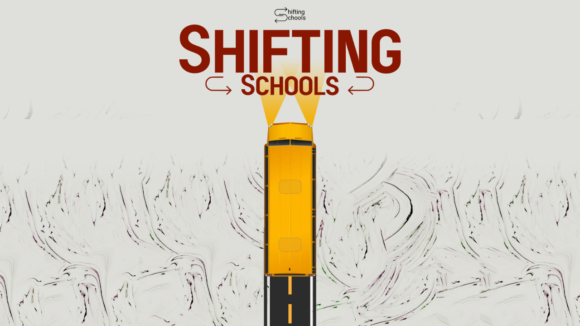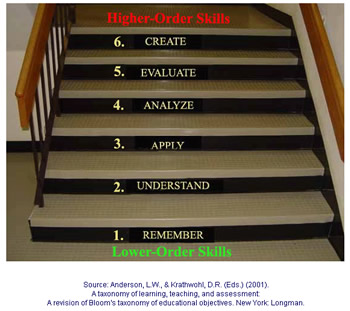
Bloom's Taxonomy Revisited
Bloom’s Taxonomy the foundation for most educators, and education through the last part of the 20th Century looks at Lower-Order Thinking Skills and Higher-Order Thinking Skills. Most educators no matter where they have been educated at one time or another have probably come across Bloom’s Taxonomy. The problem is, created in 1954 does it still apply today?
Found on the American Psychological Association’s (APA) web site is a new look at Bloom’s Taxonomy written for the learner of the 21st Century.
What does this new taxonomy mean for teaching? Has anything changed? I for one find it refreshing that we have taken this age old educational foundation tool and reworked it to work in a new age. An age where our students are engaged in the Higher-Order Skill of creating more than we realize. They create videos on YouTube, profiles on myspace, and encyclopedias at wikipedia.
Our students today are natural creators of information and according to this new taxonomy of Basic Skills are engaged in their own learning at a very high level. However, where do we as an educational system engage students? Reflecting on last year and the majority of what I saw happening in classrooms I would say that education is still focused on the lower-order skills of 1. Remembering 2. Understanding and 3. Applying. When our students, in their personal lives, are already at a level 6. Creating, they come to schools where they feel ‘dumb downed’ or disconnected. This might be the first time that a taxonomy actually shows that we are under teaching our students.
The two most missed levels in my experience are levels 4 and 5 Analyze and Evaluate. Some teachers do have students create projects: videos, podcasts, posters, etc, but do we teach students to analyze and evaluate the quality of these product? To me, that is where we need to focus. Our students are already creating, but do they know how to evaluate good creations? I think art does this better then any other subject area. In most art classes you take time to really evaluate and analyze art, looking at color, the angle of light, the texture. Do we spend time like that in other subject areas evaluating and analyzing?
Even better on the site is the Cognitive Taxonomy Circle shown below:

Then, take a second to look at how technology can or may play a role in any of these activities and products. Some lend themselves easily to the idea of using technology such as a TV or radio show. It is easy to see the role technology might play in the production of these products. But what about a recipe, a cartoon, a song? How about having a recipe wiki where students create and share their recipes with the world, or have your students add their recipes to a number of online and open recipe sites. A cartoon? There are a number of software solutions (comic life for the mac being one of the best I’ve seen) that allow students to create amazing cartoon or comic strips. A song? Have students post a song to a podcasting site, upload lyrics to an already popular song to share with the world.
Why use technology?
Because it’s the media of our time. Sure you could write a recipe and stick it on the bulletin board in the hallway (and you can still do this), but if you really want to motivate students tell them you are going to post it on the web and share it will millions of people. Technology engages and fascinates our students they love to create and they love to share what they have created with as large an audience as possible.
Earlier this year I had my students create digital stories which we uploaded to YouTube. It is the only time in my teaching career where I have had the whole class say “Can we do another one?” They are asking for an assignment, for work, to learn. They are begging me to allow them to create another one. “I can do better.” is a common statement. Sure they could have written a paper and handed it in, but would it have sparked this interest, this engagement? Probably not.
As we start this new year, I encourage you to take time to reflect on this new learning taxonomy and what it means for you, your classroom, and your students.
[tags]21st Century Education, Bloom’s Taxonomy[/tags]
Technorati Tags: Bloom’s Taxonomy, 21st Century Education









Personally I think that Synthesis should still be under Evaluation, but the “pure†definition of synthesis – combining two known things to create a new use or purpose. Then Create should be above Evaluation –defined as making new constructs to fulfill a new use or purpose, not using an old thing in a different way. I know many of my peers feel the two things are the same thing, but I don’t think that is true.
Great post. The ideas you have presented regarding higher order thinking skills is what our school started focussing on last year. We will continue to build on these this year. I totally agree with you when you say
“I would say that education is still focused on the lower-order skills of 1. Remembering 2. Understanding and 3. Applying. When our students, in their personal lives, are already at a level 6. Creating, they come to schools where they feel ‘dumb downed’ or disconnected.”
Unfortunately the solution doesn’t just lie with the classroom teacher but also with school management – availability and access to the tools.
As for Blooms taxonomy, I would like to see Create and Evaluation sitting side by side as you need to evaluate or reflect after creating.
[…] In order to get to school 2.0 however, a technology infrastructure needs to be in place. We can not change our pedagogy and adapt these new taxonomies and new theories if we do not have the tools to do so. I believe that is the phase we are now moving out of. For the past 10 years we have been creating school 1.5. As we built the infrastructure needed to move to a new way of teaching and learning. […]
secret life of blogs …
Will Richardson’s post The Next Generation of Teachers inspired a cascade of comments. For Dean Shareski at Ideas and Thoughts, this outpouring is a good reminder:Comments may be the most underrated component of a blog. For me, they breathe life…
[…] 我喜欢这个说法,对我而言,这是å¦æ ¡1.5,技术å–代了我们所åšçš„事情而已。这ä¸æ˜¯æ–°å¦æ ¡ï¼Œè€Œæ˜¯ç¿»ä¿®äº†çš„å¦æ ¡ã€‚æ–°å¦æ ¡åº”该从新教å¦æ³•ã€æ–°ç†è®ºï¼Œç”šè‡³æ–°çš„å¦ä¹ 分类法开始。å¦æ ¡2.0ä¸æ˜¯å¦æ ¡1.0çš„å‡çº§ç‰ˆæœ¬â€¦â€¦å®ƒæ˜¯å…¨æ–°çš„å¦æ ¡ã€‚å¦æ ¡1.0çš„å‡çº§å°±å¥½è±¡ç”¨æ–‡å—处ç†ä»£æ›¿æ‰‹å†™ï¼Œæˆ–è€…ç”¨æ¼”ç¤ºæ–‡ç¨¿ä»£æ›¿æµ·æŠ¥ä¸€æ ·ã€‚è¿™äº›æ˜¯æ—§ç³»ç»Ÿçš„æ›´æ–°ã€‚å¦æ ¡2.0è¦çš„是焕然一新……从我们教å¦å®žè·µçš„基础开始(大å¦ä»¬ï¼Œä½ 们在å¬å—?) 然而,è¦åˆ°è¾¾å¦æ ¡2.0,基础技术设施必须到ä½ã€‚æ²¡æœ‰å·¥å…·ï¼Œæˆ‘ä»¬å°±æ— æ³•æ”¹å˜æ•™å¦æ³•ï¼Œæ— 法调整新的分类法和新ç†è®ºã€‚我相信这æ£æ˜¯æˆ‘们开始行动的阶段。在过去10年,我们一直在创建å¦æ ¡1.5。éšç€æˆ‘们的创建,基础设施需è¦è½¬å‘æ–°çš„æ•™å¦æ–¹å¼ã€‚ 在迈å‘å¦æ ¡2.0ä¸ï¼ŒChris的科å¦é¢†å¯¼å¦é™¢, Timçš„å°å¦å’ŒDr. Tysonçš„ä¸å¦æ˜¯ä¸‰ä¸ªå¾ˆå¥½çš„范例。æ£å¦‚这三所å¦æ ¡æ‰€è¯æ˜Žçš„,迈å‘å¦æ ¡2.0,首先è¦ä»Žé¢†å¯¼å¼€å§‹ã€‚ […]
Thank u for the post.
I also enjoyed the illustration. Duringmy workshops with teachers I usually draw climbing stairs and at each step I label a level of the taxonomy. I thought I was the only one to change the pyramid into stairs. You and I share mutual things.
Thanks again